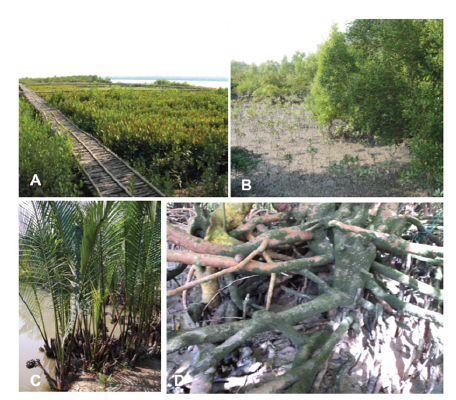- Submissions

Full Text
Examines in Marine Biology & Oceanography
Mangrove Plantation in Indian Sundarbans: Development of Coastal Livelihood and Averting Climate Change
Arun Makal1 and Gour Gopal Satpati2*
1Department of Anthropology, Bangabasi Evening College, University of Calcutta, India
2Department of Botany, Bangabasi Evening College, University of Calcutta, India
*Corresponding author: Gour Gopal Satpati, Department of Botany, Bangabasi Evening College, University of Calcutta, 19 Rajkumar Chakraborty Sarani, Kolkata- 700009, West Bengal, India
Submission: August 11, 2023;Published: August 21, 2023

ISSN 2578-031X Volume6 Issue2
Opinion
Over the last few decades, Sundarbans ecoregions of India became devastating and reduced almost 25% due to soil erosion caused by rising sea level and natural calamities such as cyclone Aila (2009), Amphan (2020) and Yaas (2021). The rising sea level causes the sinking of several islands under water. To save the coastal vegetation, agricultural lands and associated inhabitants, Nature Environment and Wildlife Society (NEWS) involves local villagers for replantation of mangroves. As we know, mangroves are the most efficient natural barriers to prevent flooding due to their morphological adaptations. Surprisingly they form an association with other living groups including algae, fungi and bacteria [1-2] (Figure 1D). Hence newly planted mangrove vegetation can be the best place for safeguarding crustaceans, fishes and molluscs (Figure 1A-C). Most of the marine food chain or food web depends on fully grown mangrove vegetation. The International Union for Conservation of Nature and Natural Resources (IUCN) has already declared Sundarbans in “The Red List of Ecosystems”. The Red list highlighted the conservation from species to ecosystem level [3].
Figure 1:A. Plantation of Bruguiera gymnorhiza; B. Plantation of Avicennia alba; C. Nypa fruticans; D. Mangrove-algae association (Photographs taken by Dr. Gour Gopal Satpati).

The Sundarbans ecosystem is one of the major biodiversity hotspots considered as native habitat for a diverse group of flora and fauna. The maximum livelihood depends on the forest’s vegetation. Fishing, collecting wood and honey from the forest are the most common activities of the inhabitants of Sundarbans (Figure 2AC). Due to rapid changes in the environment the vegetation of mangroves become affected. Periodical changes like “erosion” can cause an ultimate threat to mangrove plants (Figure 2D-E). Conservation management tools including mangrove plantation, protecting fresh water supply, farming of fishes can be suggested for better Sundarbans. Rapid decline of the fish populations makes Sundarbans “Endangered” which is a serious concern and a red alert to global climate change [3]. From the work of Barik and Chowdhury it came to be known that Sonneratia griffithii listed as ‘critically endangered’ [4]. On the other hand three species, Phoenix paludosa, Aegialitis rotundifolia and Ceriops decandra in the same study were recorded as ‘near threatened’ under IUCN status. Heritiera fomes is another example of “endangered’ species found from the regions of Indian Sundarbans [4]. In 1979, the Ministry of Environment and Forest formed the National Mangrove Committee (NMC) to protect, manage and plant mangroves under Indian government jurisdiction. Following this, in 1987, UNESCO designated Sundarbans National Park as a World Heritage Site [5]. From 2001 onwards Man and Biosphere Programme (MAB) controlled all the activities related to mangrove vegetation which denotes the involvement of humans directly to protect mangrove vegetation. Combined effort of Forest Protection Councils (FPCs) and Joint Forest Management Committees (JFMCs) took serious activities at the village level. Hence several non-profit organizations, local people and government officials should come forward to protect Sundarbans ecosystem in a natural way.
Figure 2:A-C. Livelihood in Indian Sundarbans; D-E. Destruction of mangrove plants by soil erosion (Photographs taken by Dr. Gour Gopal Satpati).

References
- Satpati GG, Barman N, Pal R (2012) A study on green algal flora of Indian Sundarbans mangrove forest with special reference to morphotaxonomy. J Algal Biomass Utln 4(1): 26-41.
- Satpati GG, Pal R (2016) New and rare records of filamentous green algae from Indian Sundarbans Biosphere Reserve. J Algal Biomass Utln 7(2): 159-175.
- Sievers M, Chowdhury MR, Adame MF, Bhadury P, Bhargava R, et al. (2020) Indian Sundarbans mangrove forest considered endangered under red list of ecosystems, but there is cause for optimism. Biol Conserv 251: 108751.
- Barik J, Chowdhury S (2014) The mangrove species of Sundarbans delta, West Bengal, Eastern India. Check List 10(2): 329-334.
- Ghosh A, Schmidt S, Fickert T, Nusser M (2015) The Indian Sundarban mangrove forests: History, utilization, conservation strategies and local perception. Diversity 7(2): 149-169.
© 2023 Gour Gopal Satpati. This is an open access article distributed under the terms of the Creative Commons Attribution License , which permits unrestricted use, distribution, and build upon your work non-commercially.
 a Creative Commons Attribution 4.0 International License. Based on a work at www.crimsonpublishers.com.
Best viewed in
a Creative Commons Attribution 4.0 International License. Based on a work at www.crimsonpublishers.com.
Best viewed in 







.jpg)






























 Editorial Board Registrations
Editorial Board Registrations Submit your Article
Submit your Article Refer a Friend
Refer a Friend Advertise With Us
Advertise With Us
.jpg)






.jpg)














.bmp)
.jpg)
.png)
.jpg)










.jpg)






.png)

.png)



.png)






